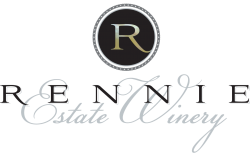Scientist hopes he invented the next grape thing 2
By Rob Houle

Graham Rennie, left, owner of Rennie Estate Winery, and Vineland Research and Innovation Centre scientist Bernard Goyette are photographed at Rennie’s home in Beasmville
It’s a method of drying wine grapes that’s been around as long as wine, but it’s never been done quite like this before.
Vineland Research and Innovation Centre scientist Bernard Goyette has invented a chamber that allows winemakers to dry grapes appassimento style while controlling climate, air flow and humidity using a unique method.
The appassimento process is one where grapes grown in cool climates with shorter growing seasons are harvested before they suffer frost bite, but are allowed to ripen further indoors. While indoors, the grapes dry out, leading to wines that are more complex and bold in flavour. There is less juice when the grapes are crushed to make wine, however, the juice that remains is less acidic, but higher in sugar content — measured in degrees brix in the wine industry. Freshly-harvested grapes in Ontario are typically 22 brix, whereas grapes dried via the appassimento process can reach 28 brix. Because there is less wine made using the appassimento process, the price of the end product is higher.
The Vineland Research and Innovation Centre and Brock University’s Cool Climate Oenology and Viticulture Institute were working with Ontario wineries to study different grape-drying techniques, such as kiln and greenhouse drying, when Graham Rennie of Rennie Estate Winery approached the centre in 2011 about the idea of developing a proprietary method. The winery owner wanted a system with a climate and humidity controlled setting that would allow grapes to slowly continue to ripen for 60 to 100 days after harvest, intensifying the flavours.
“Here in Ontario, we’re looking at the window that we have to harvest the grapes before the big frost comes and we lose our crop,” Rennie said in explaining how the grapes are harvested even though they could benefit from extra time on the vine. “The Ontario grape grower is always being challenged by trying to figure out where can I get this ripening, how can I get to the very peak of ripening that I want to make the best wine that I can.”
Rennie travelled to Italy and studied the appassimento process at two big producers of wine.
“They were using very hi-tech and innovative methods for drying the grapes,” Rennie said. “All customized rooms controlling temperature, humidity, air flow.”
Not having those resources when he returned home, he went about using a greenhouse to dry grapes. Over two years he said he lost about 25% of the grapes to mold because he could not control humidity and the grapes he didn’t lose dried out too quickly.
There had to be a better way. Off to the Vineland research centre he went to ask for help from CEO Jim Brandle.
“I said, this is what I’m doing, I need some help, you guys have a lot of smart engineers here, could we work together?”
Enter Bernard Goyette, a scientist at the research centre.
As Rennie continued to describe to Brandle what he was looking for, Goyette was working things through.
“About 15 minutes later as I finish talking, he (Goyette) has a piece of paper in front of him and he turns it around, shoves it across and says, ‘Is this what you’re looking for?’ I said, ‘Yeah, it’ll be perfect.’ “
Goyette and Rennie were soon joined by John Young, owner of Angels Gate Winery, and the trio worked to turn the rendition into a prototype.
The first prototype was a cold room with a heating system to manage humidity and fans for airflow.
“It was a system based on the forced-air cooling system that exists on the market — tunnel type with horizontal flow,” Goyette said. Think air moving east and west over grapes sitting in stacked plastic pallets.
He said the system worked relatively well, but there were some mold issues and it was labour intensive moving the grapes around so they all had air moving over them.
“It was a good start,” Goyette said.
“In 2012, we improved the system, we did some innovation on the airflow. Instead of having a horizontal airflow, we have a vertical airflow.” Think air moving north to south.
The new system involves pulling the air through the chamber from the sealing to the floor.
“This is the patented process now,” Goyette said. “We use the pallets as a duct system to conduct the air, it is connected to a plenum where we create a negative pressure that pulls the air.”
The new method means a uniform dry time for the grapes in the chamber, Goyette and Rennie said.
Now that the technology has been patented by Vineland Research and Innovation Centre, the next step is building four 7.5-metre by 9-metre prototype chambers to be used at wineries this fall. Rennie and Goyette said the units will cost between $25,000 and $30,000.
Goyette said Vineland Research and Innovation Centre is looking to licence the technology to a manufacturer.
Goyette said he envisions a “slow start” to sales, but that over the next 10 years, as the technology proves itself, more and more wineries will get onboard.
“The dream would be,” Rennie said, “that other cool climate growing regions in North America would find this technique to be value added.”
robert.houle@sunmedia.ca
Twitter: RobH_Standard
